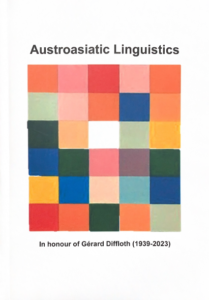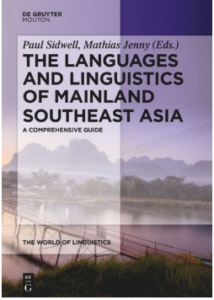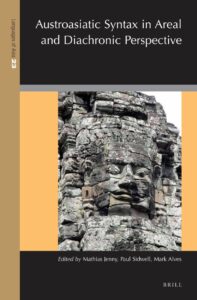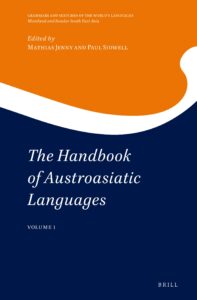Projects
On this page, you will find information about collaborative projects undertaken under the banner of ICAAL. Some of these projects are already complete, and have resulted in major publications in our field (see below). Others are currently in progress.
current projects
(Austroasiatic scholars, if you have an active project that you would like to promote here on icaal.net, please contact us!)
A Memorial Volume in Honor of Michel Ferlus (1935-2024):
It was resolved at ICAAL 12 in October, 2024 to produce an edited volume for the memory of Michel Ferlus, tentatively titled Austroasiatic Linguistics, in honour of Michel Ferlus (1935-2024). This volume will receive a limited printing; contributing authors and ICAAL 13 attendees will receive hard copies. A pdf version will also be made available free of charge here on icaal.net. The editors will be Paul Sidwell and Mathias Jenny. Contributions may be papers from the 12th ICAAL, personal tributes to Michel Ferlus, or papers that relate directly to research questions on which Michel also published (interpreted rather broadly). If you would like to submit a paper for this volume, please let Paul know ASAP ([email protected]). Contributions are encouraged to be between 10 and 20 pages long, with the first full drafts to be submitted to the editors by March 2025, and finalised by July 2025 to allow for printing before the ICAAL 13 meeting in October 2025. Please consider this an open call and help us to disseminate this call for papers to anyone who might be interested.
Htanaw Orthography Development & Linguistic Resources:
(visit website) Htanaw (Danau) is an Austroasiatic language spoken by some 3000 people in six villages in southern Shan State, Myanmar. The language is largely undescribed and has no written form. In a collaborative project of native speakers and international linguists, a practical orthography to write Htanaw with Burmese characters is being developed and language data collected and analyzed. The goal is to compile an accessible archive of Htanaw material, including texts, grammatical descriptions, and an online dictionary in English, Htanaw, and Burmese for community use as well as academic research.
completed projects
Austroasiatic Linguistics, in honour of Gérard Diffloth (1939-2023)
Editor: Paul Sidwell
This book is available to download free of charge
A multi-author edited volume published by the Myanmar Center, Faculty of Humanities, Chiang Mai University, Thailand (2024).

It was with considerable shock that we learned of Gérard Diffloth’s passing in mid-August of 2023. Subsequently that October, at the 11th meeting of the International Conference on Austroasiatic Linguistics (ICAAL 11), there was no hesitation at the suggestion that Gérard should be memorialized with an edited volume produced under ICAAL auspices. Paul Sidwell agreed to serve as editor, and the volume was assembled in time for publication and release at ICAAL 12, held Oct. 23-25, 2024. Participants at ICAAL 12 and contributing authors were each given a hard copy of the book, and a pdf version has been made available free of charge here on icaal.net.
In the book, readers will find fourteen chapters on a wide variety of topics in Austroasiatic linguistics submitted by colleagues and friends from the ICAAL community, two personal tributes, a brief tour of the more than 400 folders of Gérard’s papers held at the Cornell University Library, a bibliography of Gérard’s publications, and even a previously unpublished study by the honoree himself: Proto-Vietic Glottal Features in Kri.
The Languages and Linguistics of Mainland Southeast Asia: A Comprehensive Guide
Editors: Paul Sidwell & Mathias Jenny
A multi-author reference volume Published by de Gruyter Mouton (2021)

This handbook offers a survey of the field of linguistics in the early 21st century for the Southeast Asian Linguistic Area. The last half century has seen a great increase in work on language contact, work in genetic, theoretical, and descriptive linguistics, and since the 1990s especially, documentation of endangered languages. This book provides an account of work in these areas, focusing on the achievements of SEAsian linguistics, as well as the challenges and unresolved issues, and provides a survey of the relevant major publications and other available resources. The following issues are addressed in this volume:
- Survey of the languages of the area, organized along genetic lines, with discussion of relevant political and cultural background issues
- Theoretical/descriptive and typological issues
- Genetic classification and historical linguistics
- Areal and contact linguistics
- Other areas of interest such as sociolinguistics, semantics, writing systems, etc.
- Resources (major monographs and monograph series, dictionaries, journals, electronic data bases, etc.)
- Grammar sketches of languages representative of the genetic and structural diversity of the region.
Austroasiatic Syntax in Areal and Diachronic Perspective
Editors: Mathias Jenny, Paul Sidwell & Mark Alves
A multi-author reference volume Published by Brill (2020)

Austroasiatic Syntax in Areal and Diachronic Perspective elevates historical morpho-syntax to a research priority in the field of Southeast Asian language history, transcending the traditional focus on phonology and lexicon. The volume contains eleven chapters covering a wide range of aspects of diachronic Austroasiatic syntax, most of which contain new hypotheses, and several address topics that have never been dealt with before in print, such as clause structure and word order in the proto-language, and reconstruction of Munda morphology successfully integrating it into Austroasiatic language history. Also included is a list of proto-AA grammatical words with evaluative and contextualizing comments.
The Handbook of Austroasiatic Languages
Editors: Mathias Jenny & Paul Sidwell
A multi-author reference volume Published by Brill (December 2014)

The handbook provides essential reference for the Austroasiatc languages, with both descriptive and comparative-historical content. Previously there a complete lack of such an essential scholarly resource on the non-Munda Austroasiatic languages – a much needed companion to the (2008) Munda Languages (Gregory D S Anderson (ed.) Routledge volume.
Austroasiatic is one of the big and important language families of South and Southeast Asia with about 170 languages spoken in nine countries stretching from India to Vietnam. The Austroasiatic languages spoken in South and Southeast Asia belong to two typologically clearly distinct groups, namely the Munda languages in central and eastern India and the group traditionally called Mon-Khmer in northeastern India and Southeast Asia. Both groups are well integrated in their linguistic environments, sharing many features with their respective neighboring languages. Geographically and typologically apart are the Nicobarese varieties, a group of languages that are poorly documented and largely inaccessible to outsiders. The Aslian languages spoken in peninsular Malaysia and southern Thailand are on the fringes of the Southeast Asian sprachbund, but show marked structural influence from Malay varieties.
With Khmer in Cambodia and Vietnamese in Vietnam only two Austroasiatic languages today serve as national languages. All other members of the family are spoken by smaller or bigger minority groups in South and Southeast Asian countries, including southwestern China. Historically the Austroasiatic languages are of great importance, as Mon and Khmer are among the earliest attested languages of Southeast Asia with epigraphic documents dating to the 6th century.
The handbook brings together international experts in the field, covering all eastern branches of the Austroasiatic family in short language sketches designed to provide maximum comparability without sacrificing linguistic adequacy. Topics covered by the language sketches include phonology, morphology and syntax. Each chapter also gives a short glossed sample text with translation. In order to guarantee maximum usefulness for linguists with different theoretical background the grammar part of the language sketches are written in a framework independent way, applying functional typological descriptive methods.
Introductory chapters about the geographical, historical, and social setting of the Austroasiatic languages, the history of Austroasiatic studies, the typology of the Austroasiatic languages, make this handbook an important source not only for linguists, but also historians and other scholars interested in South and Southeast Asia.
The introductory overview chapters as well as the descriptive language sketches, together with the additional on-line resources, make this book an important contribution to the linguistic literature in general and particularly of Asian studies.